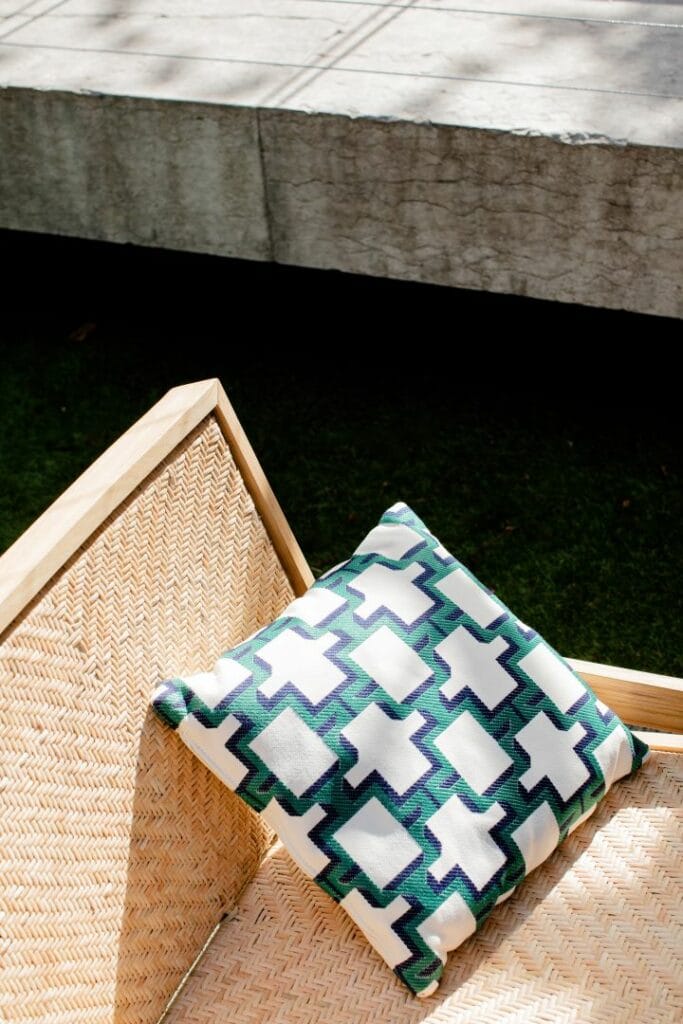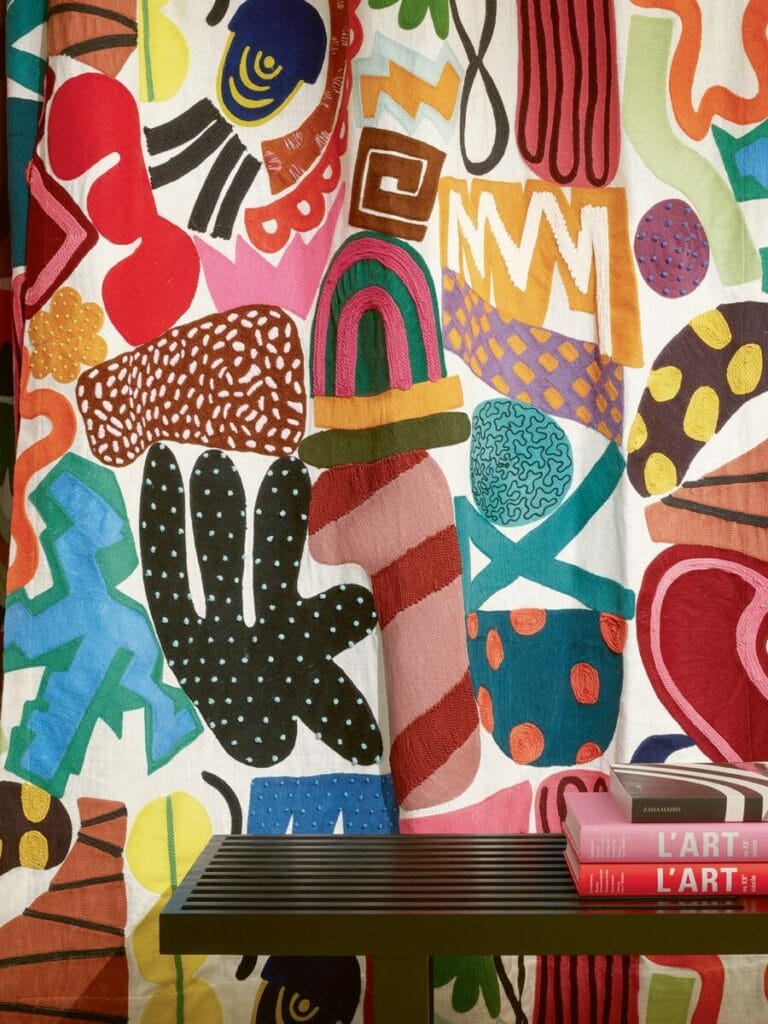Vous l’aurez peut-être remarqué ces dernières années de plus en plus de collections de tissus d’ameublement spécial extérieur – dites “outddor” – ont fait leur apparition. Ceci est en partie du à l’usage du polypropylène, elle aussi en constante augmentation.
On trouve ainsi du mobilier mais aussi de plus en plus de matière textile: tissus, tapis et autre revêtement constitué à 100 % de cette matière plastique. De quoi donner l’envie d’approfondir un peu le sujet.
Polypropylène: définition
Le polypropylène est un thermoplastique de la famille des Polyoléfines. Ce matériau plastique ne date pas d’hier puisqu’il a été développé en 1957 par la Société Montecatini et sera largement exploité dès les années 60.
Le PP est de qualité alimentaire et possède de bonnes tenues chimiques, thermiques et à la flexion, sans doute un de ses qualité les plus appréciée .
Le polypropylène connaît en réalité deux formes différentes : homopolymère et copolymère. Les qualités copolymères sont préférées pour les applications soumises à des conditions de froid. La forme homopolymère,plus dure, résiste à des températures plus élevées.
Le polypropylène est identifiable par la désignation abrégée: PP.
Usage
Il est depuis utilisé dans de très nombreuses applications: sachets, les films, les tuyaux souples, les cuvettes, jouets, secteur automobile… De plus en plus de textiles sont fabriqués en polypropylène. Son usage et sa maîtrise ont notamment permis l’essor de tissus d’ameublement outdoor.

Casamance, Le Boudoir des Etoffes
Propriétés
Le polypropylène possède un aspect rugueux, il est résistant et possède l’avantage d’être flexible. Ce matériau à était grandement utilisé dans l’industrie chimique et en génie plastique.
- Les couleurs, teintes dans la masse, sont inaltérables et protégées du rayonnement UV
- Le polypropylène possède la qualité majeure d’être résistant, y compris aux produits chimiques.
- Il est aussi imputrescible de nature (plastique).
- Il peut être recyclé.
Les tissus sièges en polypropylène
Ces tissus synthétiques résistants à l’usure est à la lumière sont des alliés de choix lorsqu’il s’agit de couvrir des sièges destinés à un usage extérieur tout comme quand il s’agit de couvrir un siège de salon qui subiraient une exposition lumineuse prolongées. Ils trouvent aussi naturellement leur place sur les sièges de cuisine qui peuvent demander une facilité d’entretien accrue.

Les tissus d’ameublement en polypropylène
L’usage du polypropylène s’impose ainsi à juste titre dans la conception de mobilier et de tissus dit “outdoor” c’est à dire spécialement conçus pour l’exterieur.
Dans le domaine des tissus d’ameublement destiné à un usage extérieur le polypropylène possèdent en effet des avantages remarquable: il offre à la fois une bonne résistance aux UV et lui seul peut réellement survivre sur les sièges présent aux abords d’une piscine.
Cependant le polypropylène nécessite une grande maitrise de fabrication pour nous faire oublier sa nature (et son aspect) plastique. Son toucher rugueux n’est pas des plus confortable et même s’il tend a percer aussi dans le domaine de l’habillement le « confort » offert par une telle matière plastique risque de ne pas faire l’unanimité..
Seul les plus grands éditeurs de tissus réalisent des tissus d’ameublement en PP digne de ce nom (avec un touché qui ai l’air naturel). Ces tissus destiné tant à un usage intérieur qu’extérieur possèdent alors des qualités esthétiques et techniques tout à fait satisfaisantes.

Les plus prestigieux éditeurs de tissus outdoor : Les marques qui proposent les plus beaux tissus d’ extérieurs haut de gamme
Si vous êtes à la recherche d’un tissu d’ameublement d’extérieur haut de gamme pour votre projet intérieur ou extérieurs c’est auprès des marques les plus prestigieuses que vous trouverez les plus belles étoffes. Ci dessous une liste non exhaustive d’éditeurs de tissus d’ameublement proposant de somptueux tissus d’extérieur.
🇫🇷 1. Pierre Frey
Atouts : motifs patrimoniaux réinterprétés, technicité invisible, textures nobles
Orientation : assises de jardin d’hiver, mobilier de terrasse, usage mixte intérieur/extérieur
Voir les collections : https://www.pierrefrey.com/fr/tissus?filter_type=outdoor
🇮🇹 2. Dedar
Atouts : sophistication italienne, couleurs pointues, douceur au toucher
Orientation : terrasses design, mobilier d’auteur, projets résidentiels contemporains
Voir les collections : https://www.dedar.com/en/products/fabrics?cat=collections-outdoor
🇫🇷 3. Élitis
Atouts : motifs audacieux, effets tissés, finition très travaillée
Orientation : coussins et rideaux en véranda, salons d’extérieur chic, hôtels de charme
Voir les collections : https://www.elitis.fr/fr/tissus/outdoor
🇫🇷 4. Lelièvre Paris
Atouts : raffinement discret, palettes sobres et luxueuses, techniques innovantes
Orientation : nautisme, hôtels 5 étoiles, canapés outdoor haut de gamme
Voir les collections : https://www.lelievreparis.com/fr/tissus?filter_type=outdoor
🇫🇷 5. Nobilis
Atouts : textures denses et élégantes, faux-unis texturés, style classique chic
Orientation : résidences d’architecte, yachts, mobilier extérieur raffiné
Voir les collections : https://www.nobilis.fr/fr/tissus/outdoor
🇪🇸 6. Gastón y Daniela
Atouts : esprit décoratif ibérique, bonne tenue technique, finitions soignées
Orientation : terrasses méditerranéennes, villas historiques, chaises longues stylisées
Voir les collections : https://www.gastonydaniela.com/en/collections/fabrics
🇩🇪 7. Sahco (Kvadrat)
Atouts : esthétique minimaliste, fibres performantes, raffinement sobre
Orientation : hôtels contemporains, mobilier de designers nordiques, projets mixtes in/out
Voir les collections : https://www.kvadrat.dk/en/products/sahco/fabrics?filter=outdoor

Bonus : marques techniques hautes performances
🌍 Sunbrella
Atouts : robustesse extrême, vaste palette de textures et de couleurs
Orientation : mobilier professionnel, parasols, espaces publics exposés
Voir les collections : https://www.sunbrella.com/outdoor-fabric
🇺🇸 Perennials
Atouts : toucher textile haut de gamme, résistance aux UV, lavabilité parfaite
Orientation : projets résidentiels et hôteliers de très haut standing
Voir les collections : https://www.perennialsfabrics.com/performance-outdoor-fabrics/
🇮🇹 Mariaflora
Atouts : finitions luxueuses, tissages naturels, douceur et tenue
Orientation : restauration de prestige, terrasses sur-mesure, hôtellerie slow luxe
Voir les collections : https://www.mariaflora.com/collections
🇫🇷 Serge Ferrari
Atouts : technologie composite, ultra-durabilité, stabilité dimensionnelle
Orientation : pergolas, voiles d’ombrage, mobilier urbain ou nautique de haute technicité
Voir les collections : https://www.sergeferrari.com/fr/produits/textiles-pour-la-protection-solaire
Où denicher toutes ces marques en un seul endroit ?
Des magasins de tissus d’ameublement spécialisé dans la distribution de tissus haut de gamme comme Le Boudoir des Etoffes vous fourniront facilement l’ensemble des tissus de ces éditeurs si vous êtes en Europe.
Polypropylène et écologie : que vaut vraiment cette fibre textile ?
Matériau prisé dans les tissus d’ameublement et les textiles techniques, le polypropylène (PP) intrigue autant qu’il interroge. Résistant, léger, peu coûteux, il coche de nombreuses cases pratiques. Mais que vaut-il d’un point de vue environnemental ? Voici un décryptage sans filtre pour éclairer vos choix.
1. Teinture dans la masse = moins de pollution
Contrairement à de nombreuses fibres synthétiques ou naturelles, le polypropylène est teint dans la masse. La couleur est intégrée directement à la matière fondue avant extrusion, évitant ainsi les bains de teinture et leurs résidus chimiques. Résultat : moins d’eau, moins de produits, moins de rejets.
2. Une fibre recyclable
Techniquement, le polypropylène est un thermoplastique classé recyclable (code 5). Il peut donc être fondu et reformé. Mais dans les faits, la filière textile peine encore à organiser un recyclage efficace de cette matière, notamment en boucle fermée.
3. Un champion de la durabilité
Résistant à l’abrasion, aux UV, à l’humidité et aux moisissures, le PP est utilisé pour des sièges de transport, des coussins d’extérieur ou des moquettes à fort passage. Un textile durable est un textile qui ne se remplace pas vite.
4. Léger = moins d’empreinte logistique
Sa densité très faible en fait une matière ultra légère. Cela a un impact réel sur le transport : moins de poids, moins de carburant, moins d’émissions.
❌ Les limites environnementales du PP
1. Une origine pétrochimique
Le polypropylène est dérivé du pétrole. Sa fabrication dépend donc d’une ressource fossile non renouvelable, avec une empreinte carbone importante dès la production.
2. Non biodégradable
En fin de vie, le PP met plusieurs centaines d’années à se décomposer s’il est enfoui ou dispersé. Il ne se désintègre pas naturellement comme le lin ou la laine.
3. Peu recyclé dans la réalité
Même s’il est recyclable en théorie, très peu d’installations traitent aujourd’hui les textiles en PP. Le plus souvent, ils finissent incinérés ou en décharge.
4. Émissions de microplastiques
Le PP libère moins de microfibres que le polyester, mais il en émet tout de même, surtout à l’usage industriel ou au lavage répété. Ces particules finissent dans l’eau ou l’air et posent un problème environnemental à long terme.
Conclusion
Le polypropylène n’est ni un ange, ni un démon. C’est une matière synthétique qui présente des arguments écologiques dans certains contextes (durabilité, absence de traitement chimique), mais qui reste à surveiller en fin de vie. Le véritable enjeu ? Intégrer cette fibre dans une chaîne de valeur responsable et durable.
Le regard HART :
Utiliser un tissu en polypropylène n’est pas incompatible avec une démarche raisonnée, à condition de penser dans le temps long. Pour des usages exigeant robustesse et tenue, le PP peut être un choix pertinent — à condition d’éviter le jetable et de privilégier des productions locales ou certifiées. La durabilité reste la clé.

Digital entrepreneur and craft artisan, I use my unconventional background to share my vision of luxury design and interior decoration — one enriched by craftsmanship, history, and contemporary creation. Since 2012, I have been working daily in my workshop on the shores of Lake Annecy, creating bespoke interiors for discerning decorators and private clients.


